A Novel Technology-Based Solution for Tracking and Monitoring Surgical Site Infections
Read the Magazine in PDF
Abstract:
Surgical site infections (SSIs) are a major issue for patients and healthcare systems. Belle Vue Clinic, a leading multi-speciality hospital in Kolkata, has implemented an innovative approach to track all operated patients, identify SSI incidence, analyze the data, and take appropriate corrective and preventive measures. This paper outlines the problem, the diagnosis, the remedy, and the improvement of the SSI tracking system, as well as the results achieved.
Organization Profile:
Belle Vue Clinic is a leading multi-speciality hospital in Kolkata, offering comprehensive and affordable healthcare services to patients from across the country. With a capacity of 304 beds, the clinic is renowned for its excellence in the fields of Cardiology, Critical Care, Nephrology, Gastroenterology, Gynaecology and Obstetrics, Trauma and Orthopaedics, Reconstructive plastic Surgery, ENT, Paediatrics, Oncology, Neurology, Bariatric Surgery, Dermatology, Urology, Emergency Services, and complete Outdoor Diagnostics. Founded by the late Shri M.P. Birla and his wife, Late Smt. Priyamvada Birla, the institution, is widely recognized for its advanced medical management. Belle Vue Clinic has been accredited by NABH (the National Accreditation Board for Hospitals and Healthcare Providers) and NABL (the National Accreditation Board for Testing and Calibration Laboratories) for pathology services (specific parameters as per scope), making it one of the most trusted and premier healthcare institutes in the region.
Introduction
Patient care is significantly impacted by the control and prevention of infections, especially those acquired in hospitals. Such disorders severely affect the patient’s health and drain the hospital’s resources. Despite advances in surgical techniques and the use of antibiotics, surgical site infections (SSI) remain a significant issue for patients and the healthcare system. To address this, Belle Vue Clinic has implemented an innovative approach to track all operated patients, identify SSI incidence, analyze the data, and take appropriate corrective and preventive measures.
Moreover, requiring regular monitoring and data collection, hospital-acquired infections can have severe consequences for patients and healthcare systems. To address the burden of surgical site infections (SSIs) at Belle Vue Clinic, an innovative approach was implemented to track all operating patients and identify SSI incidence. The data is analyzed to implement appropriate corrective and preventive measures. However, challenges still exist in post-discharge patient follow-up and SSI monitoring, highlighting the need for validated systems to address these issues. The primary problem is that there is no tracking of surgical site infection in postoperative patients and no monitoring of post-surgery patients after discharge. Plan to create a database of post-surgical patients on follow-up and a technology-based application for sending alerts to patients.
Outcome :
The IT department has developed a mobile app called “SHIVAM DASHBOARD” for post-surgical patients. It sends alerts every seven days for one month, except for orthopaedic cases, which are followed up every seventh day for one year to detect signs of infection. The module is password-protected and only accessible by the infection control team, which includes the infection control nurse and coordinator. Patients submit their details through a Google form, which is then forwarded to ssifollowupbellevue@gmail.com. The infection control department analyzes the data and saves it in an Excel sheet stored on the server for future reference.
Through the implementation of various improvement strategies, significant progress has been achieved in addressing the identified issues within the process. To thoroughly understand the process and identify areas for improvement, value stream mapping was performed, enabling the team to visualize the flow of activities and pinpoint steps that were causing delays or inefficiencies. By targeting these specific areas, changes were proposed using the ESCAP model, ensuring that improvements were made systematically and effectively.
Furthermore, a fishbone analysis was conducted to determine the root cause of the delays encountered in the process. This analysis helped identify the underlying factors contributing to the inefficiencies, allowing the team to develop targeted solutions and address the root causes directly.
These improvement actions were undertaken to improve resource utilization and validate data. By streamlining the process and removing bottlenecks, the utilization of resources has been optimized, resulting in improved efficiency and reduced delays. Additionally, through the implementation of these improvement measures, the accuracy and reliability of the collected data have been validated, ensuring that the information obtained is trustworthy and useful for decision-making purposes.
A series of steps were followed to ensure the successful replication of the improvement measures. First, the SMS template and Google form, part of the improvement strategies, underwent a validation process. This validation aimed to verify their effectiveness and functionality, ensuring they could be replicated in other areas of the organization.
Following the validation, a test run was conducted, allowing the team to familiarize themselves with the new system and identify potential issues or improvement areas. The team then began using the system regularly, integrating it into their workflow to streamline the process and capture necessary data efficiently.
To monitor and track the progress, a tracker sheet in Excel was implemented and is being maintained by the team. This sheet monitors and records relevant data provides visibility into the process, and facilitates analysis and decision-making.
Finally, a monthly analysis is conducted to assess the effectiveness of the cloned improvement measures. This analysis enables the team to evaluate the impact of the replicated strategies, identify areas for further improvement, and make any necessary adjustments to ensure continued success.
By following these steps and actively monitoring the replicated improvement measures, the organization can ensure sustained benefits and positive outcomes throughout different areas, promoting a culture of continuous improvement and driving positive change.

Conclusion:
Belle Vue Clinic’s innovative approach to tracking SSI incidence has resulted in improved patient satisfaction, effective utilization of manpower, improved data management, improved communication, and improved data validation. The system has saved time and improved the knowledge of the CSSD staff. The success of this system has been demonstrated through tangible and intangible results. However, challenges still exist in post-discharge patient follow-up and SSI monitoring, highlighting the need for validated methods to address these issues. Future research can focus on developing validated strategies to address these challenges.




